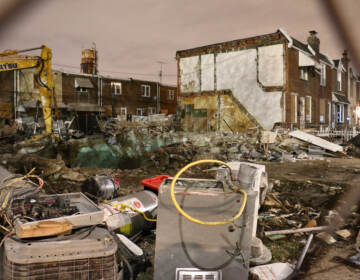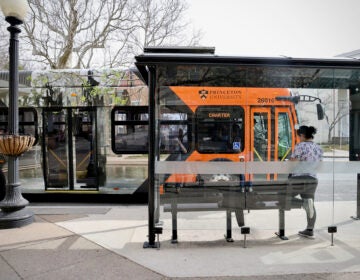PGW’s pipeline replacement plan will cost up to $8 billion and ignores climate impacts, study says
The report has a number of regulatory recommendations, which could help give PGW, the city, and ratepayers a more accurate accounting of the gas main replacement program.

Philadelphia Gas Works at 1601 S. Broad Street. (Nathaniel Hamilton for WHYY)
This story is part of the WHYY News Climate Desk, bringing you news and solutions for our changing region.
From the Poconos to the Jersey Shore to the mouth of the Delaware Bay, what do you want to know about climate change? What would you like us to cover? Get in touch.
Philadelphia Gas Works customers are on track to spend $6 to $8 billion to replace aging gas pipes over the next 35 years, locking in decades of fossil fuel use at a time when the city of Philadelphia is committed to carbon neutrality by 2050. The inflation adjusted dollars likely represent the largest energy infrastructure investment in the city. And the utility will miss its target by 20 years as per-mile costs of replacement have increased 8.5% annually since 2015, according to a new report released Monday.
“The economics of gas distribution networks is really falling apart,” said Dorie Seavey, an economist and independent consultant who authored “Philadelphia’s Gas Pipe Replacement Plan: How much will it cost and does it make sense?” for the nonprofit climate solution think tank HEET. “And we can’t just keep doing business as usual. There’s a profound need for new thinking.”
HEET has advocated the use of networked geothermal as an alternative to replacing some of the aging pipes, as one solution. The city has committed $500,000 for PGW to conduct a networked geothermal pilot project as part of its business diversification plan.
PGW spokesman Richard Barnes said in a statement that it looks “forward to partnering with HEET and other organizations to help crystalize the energy opportunities that lie ahead.”
PGW is the largest municipally owned utility in the country. It operates about 6,000 miles of pipe running beneath the city’s streets, which provide natural gas to about 500,000 people. More than half of those pipes are considered “at risk,” meaning they could leak and potentially explode.
Cracked and leaky gas pipes have caused a number of deadly explosions dating back decades. Recently, in 2019, an explosion at a house in South Philadelphia killed two people and destroyed five rowhouses. Two years later, another South Philadelphia home explosion injured three people. In August, 2022, the Pennsylvania Public Utility Commission approved a plan for PGW to speed up replacements.
“Safety needs to be an absolute priority,” said Seavey. “And there are some times when a pipe just has to be replaced. But the notion that you’re going to do wholesale replacement of all vintage pipe without looking at whether there are cost effective alternatives to me doesn’t make any sense.”
Seavey says new technology allows for pipeline repair that could be cheaper and could extend the life of the pipe for another 10 years.
“My advice would be to create a program [that] strategically identifies the pipe that really should be replaced today,” she said. “Second, to put in place a really rigorous leak detection and repair program using some of these advanced technologies.”
The report shows PGW spending $121 million on its gas replacement program each year, which includes main replacements as well as the cost of financing the debt associated with borrowing.
Seavey says the real costs to the utility are unknown even to its own executives, because regulatory frameworks limit its outlook to five-year increments. “And that constricted time horizon does not make sense when you are facing the kind of risks that we are facing with respect to climate change,” she said.
Complicating the picture is the estimated 30% of its customer base who are reliant on federal aid through LIHEAP to pay their bills. Seavey ballparked $25 to $32 million a year in revenue from federal subsidies, but she said PGW could not provide up to date figures. The concern is that more affluent customers will transition themselves away from gas stoves and gas furnaces, leaving the utility with a higher percentage of low-income customers and increasing its reliability on federal dollars.
Several national trends will impact PGW’s future, she said.
“Number one, demand for gas is going to decline, so consumption is going to go down. Number two, the customer base is going to shrink. And three, the price gap between electricity and gas is narrowing. So those three things are going to matter a lot when the customer base is so heavily weighted towards low-income households.”
The moving target of aging pipes
The report uses publicly available data as well as information gained through Right-to-Know requests to conclude that PGW’s pipeline replacement plan will not have all the current at-risk pipes replaced until 2078, 20 years after the targeted date. And even then, PGW will have to start replacing what Seavey calls “vintage pipes” installed in the 1970s and 1980s.
“It’s a moving target,” said Seavey. “By 2058 I calculate there will be 387 miles of leftover pipe from the vintage pipe that exists right now plus another 370 miles of pipe that will be sort of newly vintage.”
Gas distribution pipes have a typical economic lifespan of about 60 years for investor owned utilities aiming to make a return on their investments, she said. But PGW is not an investor owned utility and has a complex structure within the city government.
The report takes up the issue of PGW’s investments in gas processing facilities, something that has garnered criticism from climate activists but is viewed as a way to create a stable source of income. Between 2023 and 2027, PGW plans to spend $270.4 million for work on its two LNG plants, along with nine city “gates,” or facilities that receive high pressure natural gas from transmission lines. It also installed 27 new miles of mains, which were not replacements, in the last six years.
The utility often refers to the transition away from carbon intensive energy and toward renewables as complex.
“The pursuit of carbon neutrality involves balancing the often-competing goals of safety, reliability, affordability and sustainability,” said PGW spokesman Barnes in a release. “HEET’s use of data and analytics presents precisely the type of informed debate that is necessary to make progress. While the considerations and impacts we must weigh are broader than those of HEET’s study, we welcome and even pursue other perspectives and particularly expertise from other markets and geographic regions.”
The report has a number of regulatory recommendations, which Seavey says could help give PGW, the city, and ratepayers a more accurate accounting of the gas main replacement program. These include greater transparency of the replacement programs costs and activities; increased regulatory oversight of the utility’s capital spending on the pipeline system; a multi-decade consideration of climate, equity, affordability and public health; and the requirement to evaluate alternatives to natural gas.
Seavey admits PGW is in a tough position.
“But it’s such an important moment to roll up the sleeves and work on how to weatherize and improve the energy efficiency of the building stock and figure out ways for low income Philadelphians to have thermal and energy supplies to heat their homes, to cook with, to run their dryers that are going to be affordable.”
WHYY is your source for fact-based, in-depth journalism and information. As a nonprofit organization, we rely on financial support from readers like you. Please give today.







